Could solar power recharge an electric campervan for off-grid adventures?
Electric campervans are an exciting but daunting prospect! Electric vehicles have so much to offer in terms of sustainable transport and cheaper ‘refuelling’, but the distance which electric vans can cover between charges isn’t very impressive, and everyone thinking about investing in electric is fearful of the well-known range anxiety!
For a long time, campervans have been using solar power to supplement their power usage which has proved to be a reliable and effective method of recharging leisure batteries. So the idea of using the same system to top up the power-train (or traction) battery of an EV seems like a no brainer.
But how much energy could we really harvest from panels on the roof of a campervan? Would they be powerful enough to top up the traction battery, or, even better, could we completely rely on solar power as the main charging source, giving us the freedom to roam further without needing to find charging stations?
Let’s run through some theoretical calculations to see how viable this would be, and then consider the practicality of charging a high voltage, high capacity battery bank from solar panels on the roof of a campervan.
How much energy could we theoretically harvest?
The amount of solar energy we can harvest will depend on the energy from the sun at a given location and time of year, the available roof space and the efficiency of the solar array. We’ll run the numbers for two different van sizes, assessing their performance in summer and winter, as well as in different locations! The large van will be able to fit more solar panels on its roof, but the small van will have better electrical consumption (which is the equivalent to miles per gallon).
Large electric campervan
Let’s use the new Fiat e-Ducato for this example – the diesel Ducato was a popular van for campervan conversions and we’re all intrigued by this new electric upgrade. Plus, the Ducato’s have a boxier shape which means they have more room on their roof than a Sprinter, which is better for fitting more solar! To cover as much space as possible, we could fit 4x 375W JA Solar solar panels on the roof of an L2H4 e-Ducato, giving us a total solar panel power of 1500W.
Because the available space for solar panels is at a premium, it’s important to use the most efficient solar panels available. For example the Victron BlueSolar monocrystalline range of solar panels achieves 18% efficiency, but dig a little deeper and 22% efficiency is possible with certain panels. To give the dream of truly self sufficient travel a chance, we’re using the most efficient panel currently available.
Unfortunately, there are more inefficiencies and losses to account for that will affect total solar yield.
Firstly, the rated power of a solar panel (375W in this example) is based on the best possible conditions for energy harvesting – that means zero cloud cover and the sun perfectly aligned with the solar panel in both inclination and orientation. As soon as the sun drops lower in the sky, the light hits the panel at a more acute angle and the energy conversion is much less efficient. Throughout the summer in London, a flat solar panel will receive 8% less energy from the sun throughout the day and 76% less in the winter. These percentages will vary depending on where you are in the world, as the angle of the sun and daylight hours vary.
As well as this, you only benefit from the perfect angle of the sun in the middle of the day. In the morning and the evening, when the sun is much lower in the sky, you also experience a large decrease in effectiveness.
The loss of energy in the charge controller will also affect yield, which manages the power produced by the solar panels and is a vital part of any solar set-up. Victron MPPT charge controllers have an efficiency of around 98%. For reference, a typical PWM charge controller operates at 75–80% so we won’t be using one of those!
Depending where you’re based in the world, you may not experience as many sunny days as you’d like. In Barcelona, the average number of sunny days in the summer is 26, whereas in London, this is only 16.
To ensure we’re using accurate values for our calculations, we’ve used the Victron MPPT calculator which has a Forecasted daily yield graph. Simply input the values for the solar panels you’re using and your location, and it will tell you the estimated daily yield of your solar panels for that location at a given time of the year.
Once we have this figure, we still need to factor in the inefficiency of a MultiPlus (93%) and the EV charger we’ll be using to recharge the vehicle (usually around 84%).
In summer
London, UK
- Forecasted daily yield = 4.8kWh/day
- Efficiency of MultiPlus = 93%
- Efficiency of charger = 84%
4.8kWh x 93% x 84% = 3.7kWh/day recharge
Considering the e-Sprinter has a battery bank of 55kWh, if you had a completely flat battery, you’d need to park up for 15 days in perfect sunshine to get a full recharge!
However, if we consider the e-Ducato’s electrical consumption, which is around 38kWh per 100km (380Wh per 1km), we can calculate how many extra kilometres of range we’ll get from our solar panels per day.
Range per day = power per day ÷ consumption
3700Wh/day ÷ 380Wh = 9.7 km/day
Barcelona, Spain
- Forecasted daily yield = 6.8kWh/day
- Efficiency of MultiPlus = 93%
- Efficiency of charger = 84%
6.8kWh x 93% x 84% = 5.3kWh/day recharge
If you had a completely flat battery, you could fully recharge your battery in 10 days in the perfect sunshine in Barcelona.
Once again, considering the e-Ducato’s electrical consumption, we can calculate how many extra kilometres of range we’ll get from our solar panels per day.
5300Wh/day ÷ 380Wh = 13.9 km/day
In winter
London, UK
- Forecasted daily yield = 2kWh/day
- Efficiency of MultiPlus = 93%
- Efficiency of charger = 84%
2kWh x 93% x 84% = 1.6kWh/day recharge
In London in the winter, the low angle of the sun will reduce the panel’s daily yield by 76% due to less daylight hours and more acute angle of the sun on the solar array will reduce the available charging power down to only 1.6kWh per day – that equates to only 4.2km of extra range per day! It’s also worth noting that 1.6kWh is broadly equivalent to a medium-power use case for running appliances off-grid, so realistically in winter you are unlikely to increase your driving range.
Barcelona, Spain
- Forecasted daily yield = 4kWh/day
- Efficiency of MultiPlus = 93%
- Efficiency of charger = 84%
4kWh x 93% x 84% = 3.1kWh/day recharge
The solar production drops so low in the UK during winter because of our northerly latitude, but if you’re planning a trip to somewhere sunny and near the equator, such as Spain, you’ll get a much better solar yield since the sun is higher in the sky.
In Barcelona in winter you will see double the amount of sunshine as in London, so you may manage to gain 8.1km of range per day.
How much solar would you actually need to recharge a large electric campervan?
To recharge a large electric campervan around 30% of its battery capacity per day, you would need a 6750W solar array (18x 375W solar panels). This would produce around 20.5kW/day in summer in London. For context, this is 4.5 times the footprint of a Fiat e-Ducato!
Small electric campervan
Using the Nissan e-NV200 as an example, we can fit a single 375W Sunpower solar panel on the roof. However, if we create an elaborate slide out awning, this will allow us to double our solar array to 750W.
In summer
London, UK
- Forecasted daily yield = 2.4kWh/day
- Efficiency of MultiPlus = 93%
- Efficiency of charger = 84%
2.4kWh x 93% x 84% = 1.9kWh/day recharge
Considering the Nissan e-NV200 has a battery bank of 40kWh, if you had a completely flat battery, you’d need to park up for 21 days in perfect sunshine to get a full recharge – this is even longer than the e-Ducato due to the small size of the van.
The electrical consumption of the small Nissan e-NV200 is much better than the Fiat e-Ducato, at only 16.5kWh per 100km. However, as the solar array is so much smaller, our mileage gained per day only works out as fractionally more than the Fiat e-Ducato.
1900Wh/day ÷ 165Wh = 11.5 km/day
Barcelona, Spain
- Forecasted daily yield = 3.2kWh/day
- Efficiency of MultiPlus = 93%
- Efficiency of charger = 84%
3.2kWh x 93% x 84% = 2.5kWh/day recharge
If you had a completely flat battery, you could fully recharge your battery in 16 days in the perfect sunshine in Barcelona.
Once again, considering the Nissan e-NV200’s electrical consumption, we can calculate how many extra kilometres of range we’ll get from our solar panels per day.
2500Wh/day ÷ 165Wh = 15 km/day
In winter
London, UK
- Forecasted daily yield = 1kWh/day
- Efficiency of MultiPlus = 93%
- Efficiency of charger = 84%
1kWh x 93% x 84% = 0.8kWh/day recharge
In London in the winter, the low angle of the sun will reduce the panel’s daily yield by 76% due to less daylight hours and more acute angle of the sun on the solar array will reduce the available charging power down to only 800Wh per day – that equates to only 4.8km of extra range per day!
Barcelona, Spain
- Forecasted daily yield = 2kWh/day
- Efficiency of MultiPlus = 93%
- Efficiency of charger = 84%
2kWh x 93% x 84% = 1.6kWh/day recharge
In Barcelona in the winter you will manage to recharge almost twice as quickly, managing to regain 9.7km of range per day in the winter.
For both vans, the added charging power from the solar panels doesn’t really make a dent in the total battery capacity and mileage likely to be covered each day. If you’re only mounting solar panels to the roof of your van, it’s not really worth the added effort and expense for the small amount of mileage you will gain.
However, if you can accommodate considerably more solar with additional portable solar panels or an elaborate fold out solar array, it may be worth it if you will spend a lot of time off-grid in remote areas.
How much solar would you actually need to recharge a small electric campervan?
To recharge a small electric campervan around 30% of its battery capacity per day, you would need a 3375W solar array (9x 375W solar panels). This would produce around 15kW/day in summer in London. For context, this is 9 times the footprint of a Fiat e-Ducato!
How to charge an electric campervan from a solar panel
Electric vehicle’s can accept two different types of electricity to charge their traction batteries: AC or DC. The batteries themselves operate on 350-450V DC, but UK mains electricity is around 230V AC, so EVs use onboard chargers to convert AC power into DC. Recently, DC charging points have been developed which can bypass the onboard charger and charge EVs much faster.
Solar charge controllers used in campervan conversions are designed to convert the variable power from the solar panels into the correct voltage to charge 12V or 24V leisure batteries, but to charge an EV’s traction battery, we need 230V AC or 400V DC.
Unfortunately, there’s nothing on the market right now designed for this application, so unless you’re a dab hand with DIY electric circuits, charging your electric van from solar power won’t be an option.
Technically, you could plug the EV’s 230V charger into an inverter which draws power from the leisure battery (if you had the biggest inverter on the market) but you would drain your leisure battery bank faster than you could top it up with solar power (even with 7 x 140W panels!) and the process would be very inefficient due to the number of conversion steps:
There is a device which combines a solar inverter with an EV charger, but it’s intended for use with a domestic solar array of at least 6kW with a nominal voltage of around 380V DC – our example for the large van is only 1.5kW and would have a maximum power voltage of only ~150V.
For the average DIY campervan converter, it’s not yet possible to use your solar panels to charge your EV, but we know that it can be done – a handful of car manufacturers are already making the most of solar power to support their EV’s driving range.
Solar powered electric vehicles
There are a few companies which are already experimenting with the integration of solar panels into their electric vehicles.
The Sion
Sono Motors have developed an electric vehicle called the Sion, which has solar cells integrated into every body panel of the car. With a battery capacity of 54kWh, they claim a total range of 305km with good solar production, which is pretty impressive in comparison to other EVs with a similar battery size which usually have a range of around 150-250km. They claim that the solar cells add around 112km of range per week. The fact that some of the panels are on the side of the vehicle takes advantage of the sun’s energy when it’s low in the sky, meaning at least some of the panels will be at max efficiency at some point in the day…assuming you park tactically!
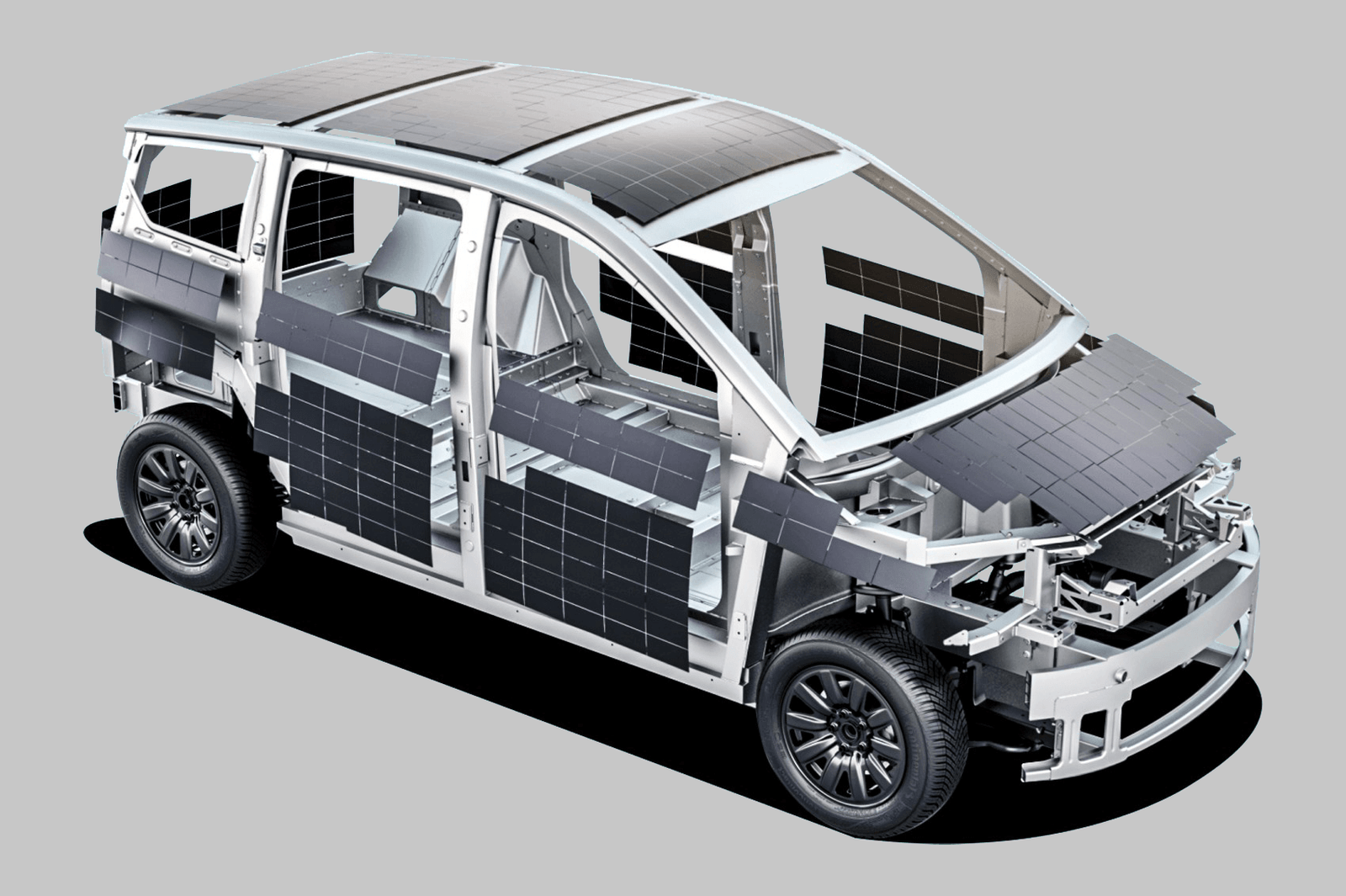
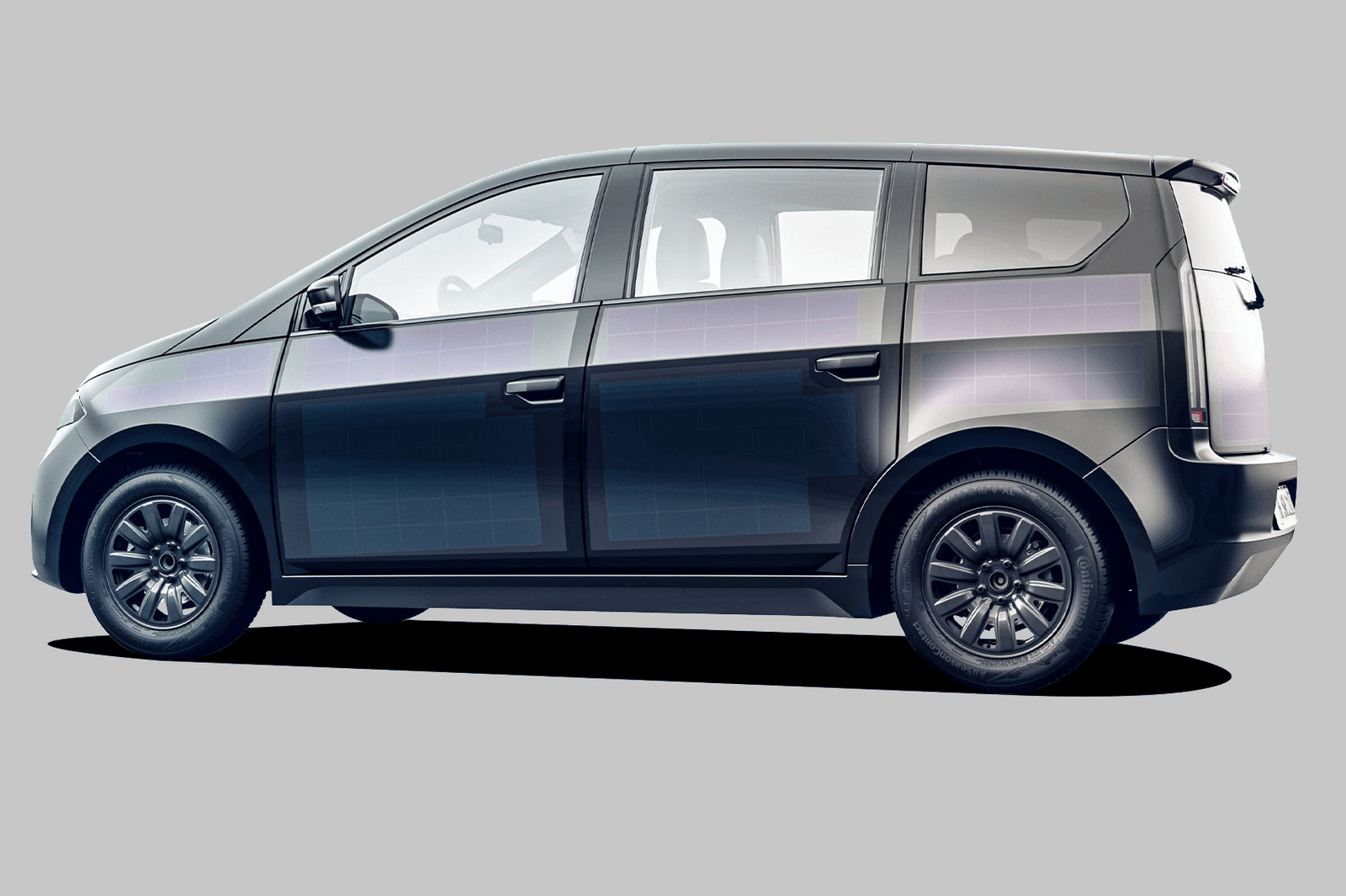
They also use panels which embed the solar cells into a clear polymer, rather than glass, and produce 220W/m2, exactly the same efficiency as the panels we used in our calculations.
Another impressive feature of the Sion is that it can act as an energy storage unit for your domestic rooftop solar power. You can purchase and install a bidirectional home charger which not only charges the Sion when it’s parked up, but also stores excess solar energy produced throughout the day and feeds it back into your home for use in the evening. This is a pretty clever use of that massive battery bank hidden inside the electric vehicle.
Lightyear One
A company called Lightyear has designed a solar powered EV which has some questionable taglines, such as ‘drive for months without charging’….
The 5m2 of solar panels which cover the roof and bonnet provide a total power of 1075W. Alongside the 60kWh battery bank Lightyear claim their car will cover a range of 725km!
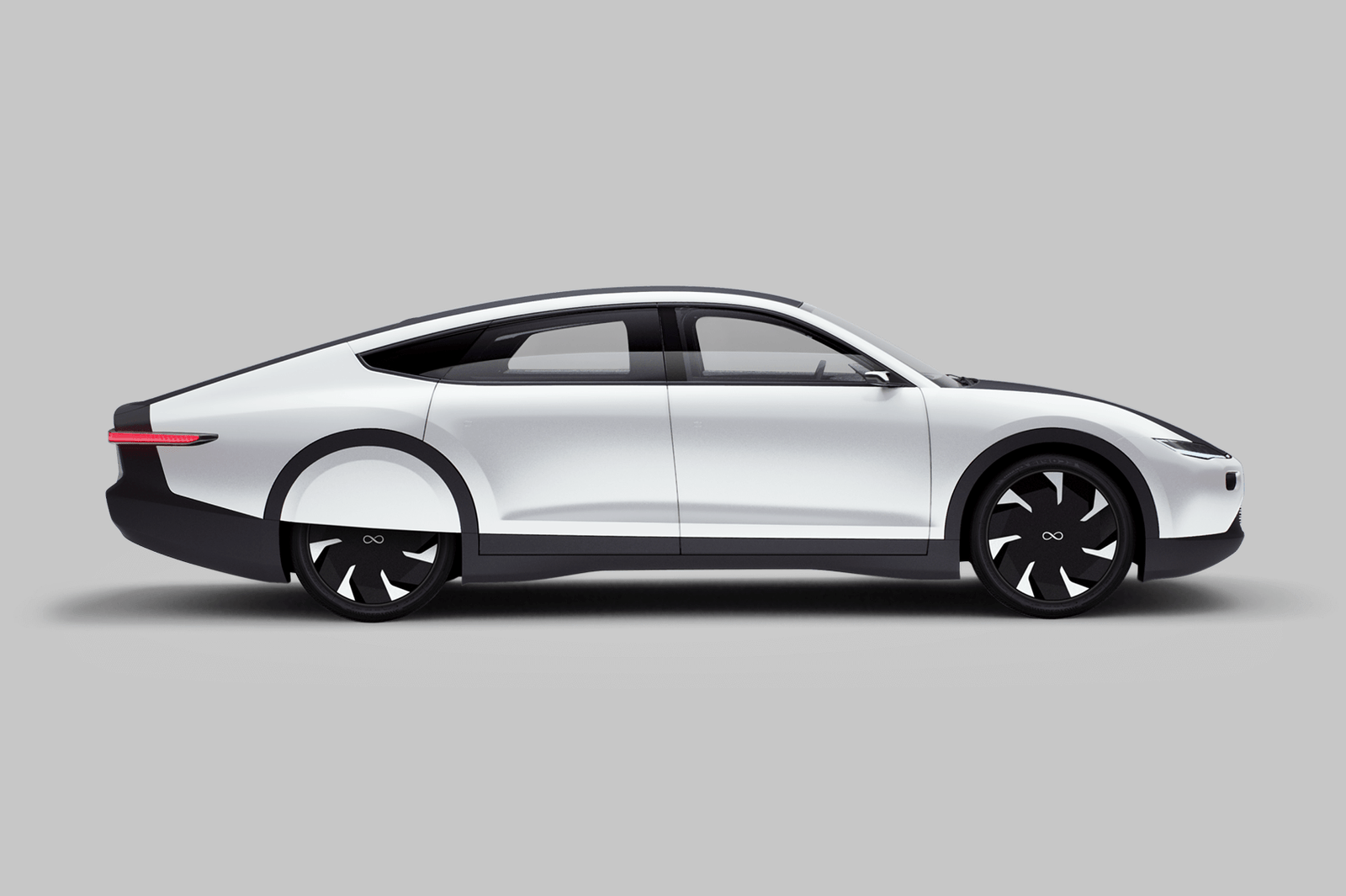

It seems to claim such a large range based on it’s super low consumption of only 8.3kWh per 100km. For comparison, the most efficient EVs on the market right now, such as the Tesla Model 3, claim around 15kWh/100km and the consumption of small vans is around 25 kWh/100km.
With such a low consumption value, the solar panels would be able to add up to 70km of range per day, making them significantly more useful than they were in our calculations for the electric vans which had much higher consumption.
Theoretically, this is impressive, but we need to take these numbers with a big pinch of salt, not only because these figures will represent the most ideal conditions for solar production and efficient driving, but also because the Lightyear One isn’t actually on the market yet, and hasn’t been subject to the official WLTP test. We’ll have to wait and see if the final version lives up to the hype!
Stella Vita RV
A group of 22 students at The Netherlands’ Eindhoven University of Technology have designed and built an RV which is solely powered by a solar panel array on its roof. They claim the Stella Vita RV can travel 730km on a full battery, with good sunlight. These numbers are a little more believable than with the Lightyear One since the solar panels cover 8.8m2 of the RV’s roof and can extend out to cover a surface area of 17.5m2 to gain maximum solar charge when parked up!
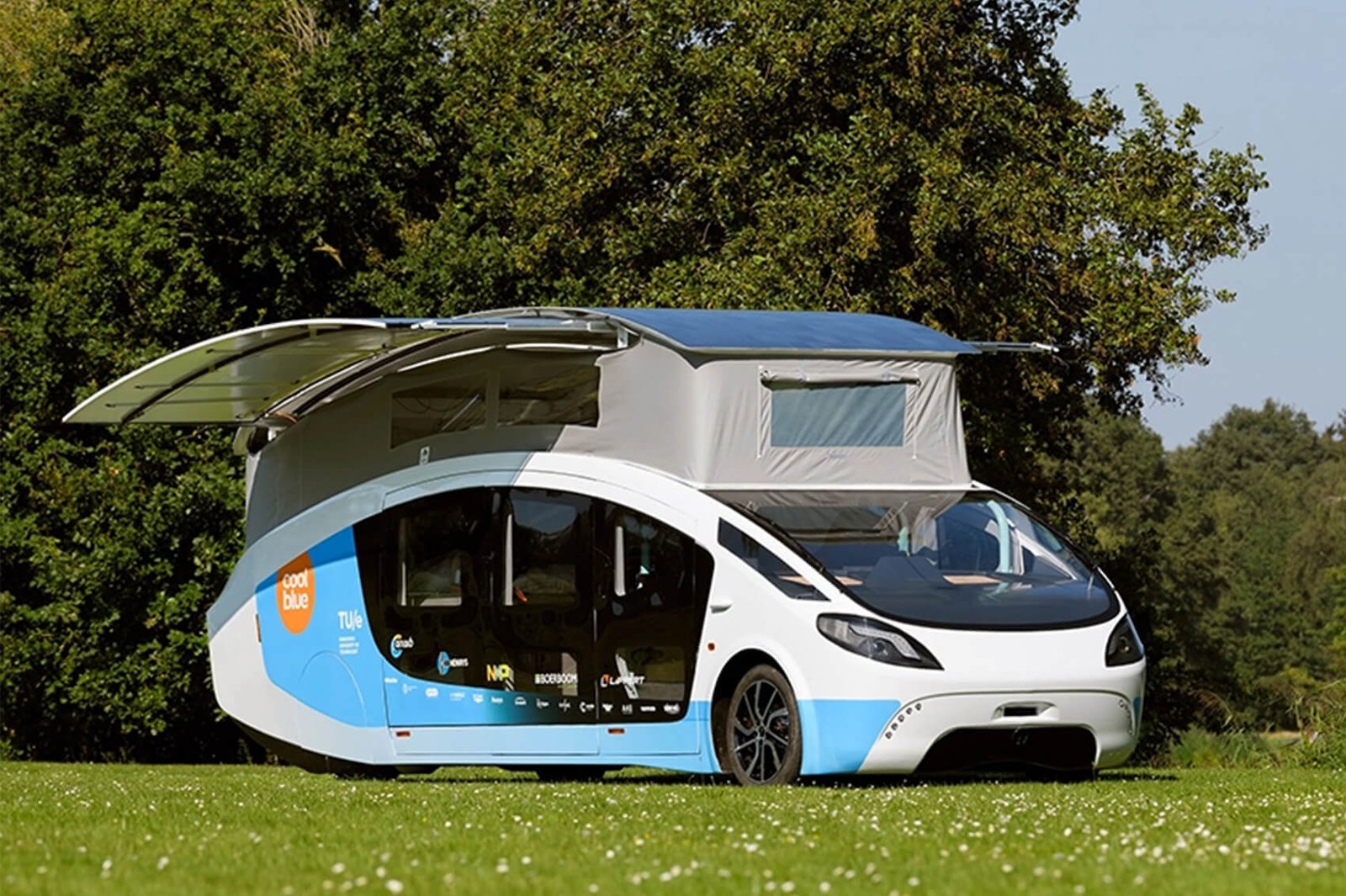
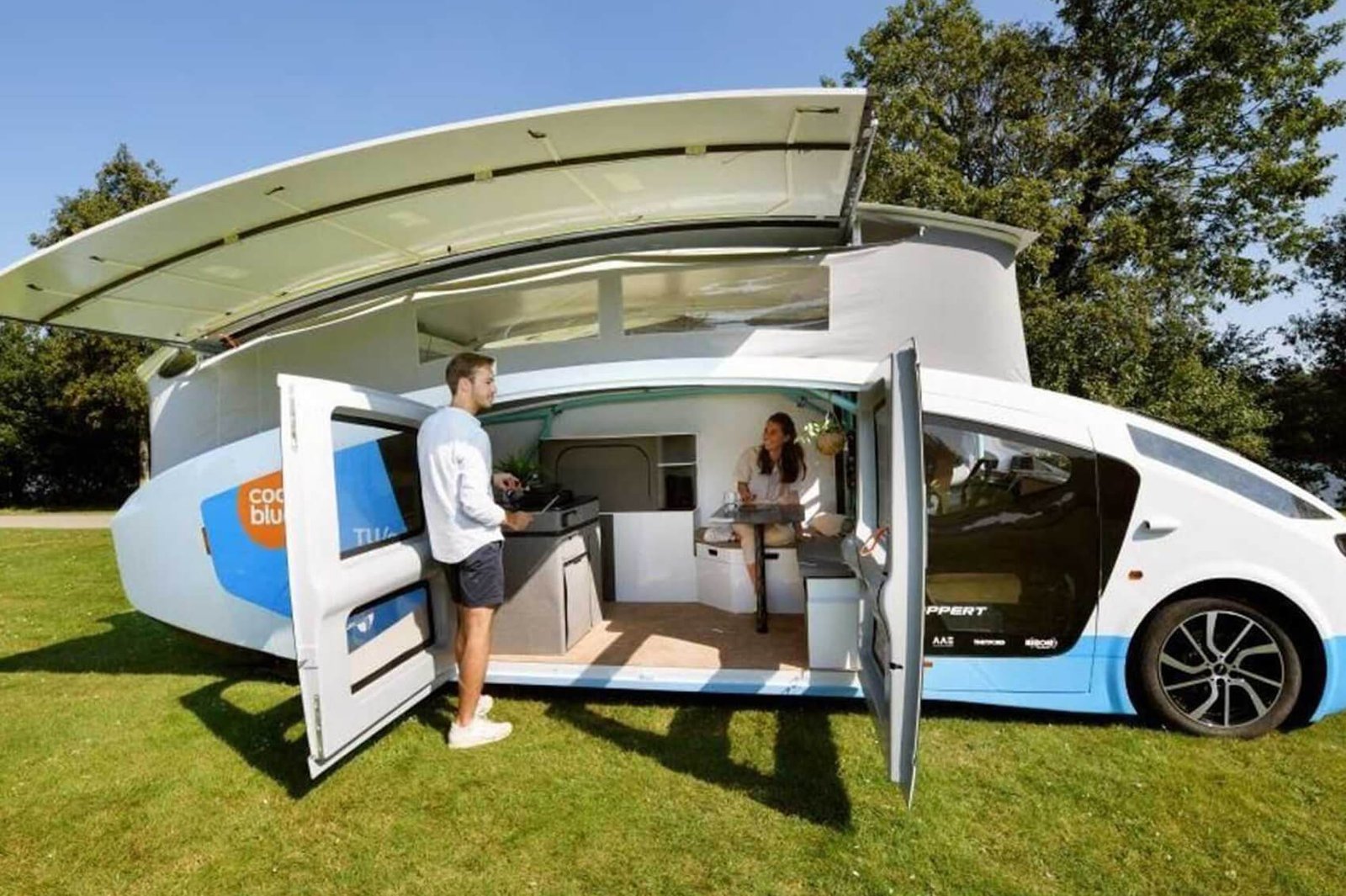
The Stella Vita RV is an amazing achievement from a group of students and very much puts the big motorhome manufacturers’ efforts to shame. There are however some significant and expensive challenges to overcome before Stella Vita could be your next campervan.
The future of solar powered campervans
The examples above show that there is some potential in using solar power to supplement electric travel, however, the technology isn’t there yet for the average DIY van-converter to connect solar panels to the vehicle’s traction battery, and for the extra range you might get, it just doesn’t seem worth it.
Nonetheless, solar panel technology is improving all the time. Solar cells are not perfect energy converters, in fact, monocrystalline solar panels can only convert around 22% of the incident sunlight, but there is constant progress being made with solar power technologies and materials. Recent research into multi-junction solar cells has made gains in the efficiency of solar cells – they use stacked layers of different materials to absorb different parts of the solar spectrum, giving them a higher efficiency than conventional single-junction PV cells. In 2020, a laboratory in Colorado produced the most efficient device to date, at 47.1%, but this technology still needs a lot more work before it’s viable for mass production.
As these efficiencies improve, and solar power becomes more viable as an option for EV charging, the right products might appear on the market for us DIY van converters and we’ll be able to power our electric campervans with free energy from the sun – a very inviting prospect for everyone trying to fund their diesel-guzzling van right now!


Thanks for breaking down those figures. I have an Env200 that is slowy getting converted to a camper/daily driver for my family and I.
I have been looking into this a while now. Have you seen James @real solar cars on youtube and elsewhere. He has developed a straight to dc bus 300w board to allow direct dc charging (installed in his chevy volt) if only the costs were sensible this would make a single 300w panel a no brainer.
I have a couple of elejoy mppt stepups (which i bought for a solar ebike + weehoo project) but can each do 400w and have a nice tiny footprint. They will charge i think upto 55v or so and so i may run both on my van to a lifepo4 battery to have a tertiary voltage. Yep losses for charging the van like this might be high but when you use that battery for cooking or ancillary devices then thats power your main pack doesnt have to deliver via the 12v and the dcdc inverter.
Anyway good luck with the Phd, and thanks again for sharing this and saving me doing the maths myself.
test
plugin hybrids for electric camper vans is the way then. if you stay longer in a place, in summertime, you can significantly minimize your gas consumption. that’s something.